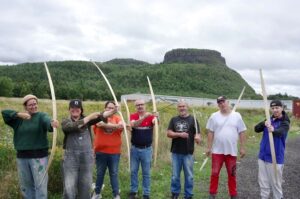Traditional Bow Making workshop connects participants to culture

By Rick Garrick
FORT WILLIAM — Fort William’s Culture and Recreation department recently held a Traditional Bow Making workshop by John Belanger on Sept. 4-5 at the Fort William First Nation Community Centre’s Cultural Room.
“Not much people know about it here so I thought it was a good idea to bring [Belanger] out and show these folks how to make their bows,” says Jeremiah Charlie, cultural coordinator at Fort William. “They’re all enjoying themselves, they all like it. I brought them some arrows so they can go and try it out after.”
Charlie says he plans to bring Belanger back again for another workshop.
“I’m trying to get into land-based teachings, so this is one of the [workshops] I wanted to start with,” Charlie says. “There are quite a few people that are interested in taking it so I’m going to try to put it on again eventually. He also teaches snowshoe making so I think we’re going to try that out, too.”
Belanger, who lives outside of Thunder Bay and does the bow making workshop for Dilico Anishinabek Family Care, says the workshop participants were awesome.
“They were super enthusiastic and it was a pleasure to teach,” Belanger says. “Everybody finished that started, there’s one still in progress but the rest of the people are putting the final finish on their bows.”
Belanger says he collects the wood for the bows from around the Thunder Bay area, including birch, maple, and elm logs.
“I want something about six inches in diameter and as knot-free as possible,” Belanger says. “I cut it on a sawmill [into] two inch strips so the back of the bow, the part that is furthest away from you when you shoot, is directly underneath the bark. That’s going to act as a lamination to hold the bow together for tension.”
John Hamilton, one of the workshop participants, says they had to file and sand the wood down to make the bow.
“There’s lots of work to it, you’ve got to keep looking and you’ve got to check for bending to make sure it’s bending completely through and not just in a couple of spots,” Hamilton says. “It’s an amazing course, I would tell a lot of people to do it.”
Hamilton says they needed to watch the details while working on the bow to make sure it is bending properly.
“When we are comfortable with how it’s bending, then we work on our handle and it goes by personal feeling,” Hamilton says. “You keep trying it so it feels nice in your hand.”
Jennifer Spence, one of the workshop participants, says she wants to learn more about her Indigenous culture, from making bows to traplines to foods and medicines.
“The science of it was intriguing, we got to learn which kind of wood was used and how it was strong,” Spence says. “It took a lot of time to get it just exactly to the shape and the smoothness. My hands are a bit busted up and tired but it was well worth it.”
Jean Marshall, one of the workshop participants, says they learned how to use several different tools during the workshop.
“John told us about how he harvested the trees and had to let them dry for a long time,” Marshall says. “So he actually did a lot of prep work before teaching us what to do. We used a spokeshave, which is a tool that you hold on both ends and it has a blade in the middle, so we would use that to shave the wood down. For me, it was really exciting because I’ve never done anything like this before and I’ve never used any of these tools before — to learn a new skill was really empowering.”

